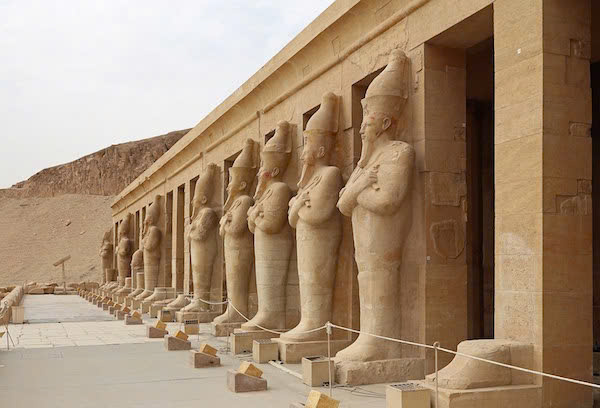Standing majestically on the west bank of the Nile at Deir el-Bahari, near the Valley of the Kings in Upper Egypt, the Mortuary Temple of Hatshepsut remains one of ancient Egypt’s most awe-inspiring monuments. This architectural masterpiece was commissioned by Queen Hatshepsut, the fifth pharaoh of the 18th Dynasty and only the second recorded female pharaoh in Egyptian history. Construction began around 1479 B.C. and took fifteen years to complete.
The Legacy of a Female Pharaoh

During Hatshepsut’s reign, Egypt experienced an unprecedented period of peace and prosperity. Her mortuary temple, reaching a height of 97 feet (29.5 meters), stands as a testament to this golden age. Dedicated to both the god Amun and herself, the temple features three magnificent terraces connected by long ramps, each designed to harmonize perfectly with the surrounding landscape. The complex includes impressive pylons, spacious courtyards, a hypostyle hall, a sun court, and various chapels and sanctuaries.
Gardens and Divine Offerings
A Paradise of Exotic Plants
The temple’s terraces once showcased luxuriant gardens filled with rare and exotic plants, including precious frankincense and myrrh trees. These gardens served both aesthetic and religious purposes, demonstrating Hatshepsut’s wealth and devotion to the gods. The cultivation of these valuable plants, essential for ancient Egyptian rituals and trade, highlighted the temple’s significance as a religious center.
Architectural Brilliance in Light and Shadow

Perhaps the temple’s most remarkable feature is its sophisticated alignment with the winter solstice sunrise. A cleverly designed light-box mechanism allows sunlight to travel along the temple’s central axis, creating a mesmerizing display. As the sun rises, it sequentially illuminates three important figures: the god Amun-Ra, a kneeling statue of Thutmose III (Hatshepsut’s stepson), and finally the Nile god Hapi. This ingenious design showcases Hatshepsut’s deep understanding of astronomy and her desire to bridge the divine and earthly realms.
Art and Symbolism

The temple walls tell Hatshepsut’s story through intricate reliefs and inscriptions. These artistic elements narrate her divine birth, her famous expedition to the Land of Punt, and her achievements as pharaoh. In a society dominated by male rulers, these carefully crafted scenes served to legitimize her reign and demonstrate her divine connection to the gods.
An Enduring Monument

Today, despite attempts by subsequent pharaohs to erase her legacy, Hatshepsut’s mortuary temple continues to captivate visitors from across the globe. It stands not only as an architectural masterpiece but as a powerful symbol of female leadership and innovation in ancient times. The temple’s enduring presence invites modern visitors to contemplate the remarkable story of a woman who challenged convention to become one of Egypt’s most successful rulers.

The Mortuary Temple of Hatshepsut remains more than just a stunning architectural achievement – it represents the triumph of human ingenuity and the lasting impact of a remarkable woman on one of history’s greatest civilizations.

